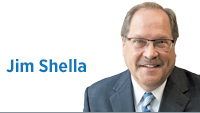Subscriber Benefit
As a subscriber you can listen to articles at work, in the car, or while you work out. Subscribe Now A recent trend in televised sports coverage calls for live shots of athletes walking into stadiums and arenas. Those athletes are often wearing headphones. I assume they are listening to music that helps them focus on the task ahead.
A recent trend in televised sports coverage calls for live shots of athletes walking into stadiums and arenas. Those athletes are often wearing headphones. I assume they are listening to music that helps them focus on the task ahead.
I’m no athlete, but my wife recently purchased a similar set of bluetooth headphones that you might see me wearing as I walk around the neighborhood or work in the yard. I’m listening to a podcast.
I listen to a lot of podcasts. In fact, I almost never listen to the radio anymore, and I’m part of a rapidly growing segment of the global population.
In 2019, there were 275 million podcast listeners, according to demandsage.com. This year, the number is 465 million. Five million podcasts are available around the world. But we podcast listeners are still in the minority.
The statistics show that only a third of Americans listen to podcasts, and just 28% listen weekly. Yet podcasting is big business. It is projected to bring in $4 billion in the United States next year.
So, what is a podcast? It’s broadly defined as an online audio broadcast. It’s a stand-alone radio show that often lasts just 10 to 20 minutes, though some go on for 90 minutes or more. They are most often available through a cellphone app such as Apple Podcasts or Spotify. Some require a subscription, but most do not. Some include commercials, but not all do.
I spell this out because I recently spoke with a friend who had no familiarity with podcasts or how to find one. I was in that same place just a few years ago. In fact, when, as host of “Indiana Week in Review,” I was first asked to direct viewers to a podcast of the program, I had no idea what I was talking about. Now I’m an evangelist for the cause.
Every weekday, I listen to “The Daily” from The New York Times and get an in-depth look at a major story of the day. The Times now has its own audio app and shares stories from the newspaper read aloud by the reporters who wrote them.
Locally, I enjoy Robert Vane’s podcast “Leaders and Legends,” and not just because he occasionally asks me to co-host it. It’s a great way to get to know memorable people on a personal level. (I should also mention that IBJ produces podcasts that feature interesting interviews with local newsmakers.)
The most popular podcast out there is “The Joe Rogan Experience.” Elon Musk smoked marijuana on one episode, and it became known for sharing misinformation and/or disinformation during the pandemic. I’ve never listened.
I’d rather spend my time with Marc Maron’s “WTF.” He’s a standup comedian who began podcasting celebrity interviews in 2009. He’s a pioneer and a good interviewer.
I also enjoy “Ted Talks Daily,” and my sister turned me on to a podcast called
“A Fly on the Wall.” Dana Carvey and David Spade are featured interviewing people connected with “Saturday Night Live.” It’s interesting to hear how big or little a role SNL played in the lives of some very famous people.
I have no ill feelings toward radio, but it’s fading, and podcasting is the future. That’s why I encourage you to figure out how to access podcasts if you don’t already know how, and to make it a regular practice if you do.
And I’ll just bet that some of those athletes preparing for battle are listening to podcasts.•
__________
Shella hosted WFYI’s “Indiana Week in Review” for 25 years and covered Indiana politics for WISH-TV for more than three decades. Send comments to [email protected].
Click here for more Forefront columns.
Please enable JavaScript to view this content.
